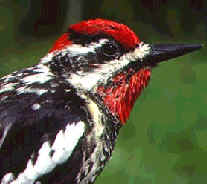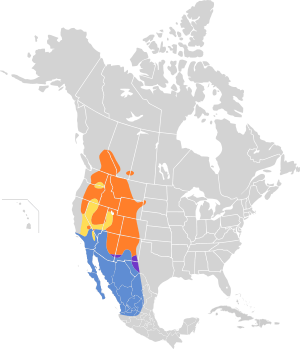Red-naped sapsucker facts for kids
Quick facts for kids Red-naped sapsucker |
|
|---|---|
 |
|
| Conservation status | |
| Scientific classification | |
| Genus: |
Sphyrapicus
|
| Species: |
nuchalis
|
 |
|
The red-naped sapsucker (Sphyrapicus nuchalis) is a medium-sized woodpecker found in North America. For a long time, people thought it was just a type of yellow-bellied sapsucker. But now, we know it is its own special species.
Contents
About the Red-Naped Sapsucker
The red-naped sapsucker is one of four types of sapsuckers in North America. These birds belong to a group called Sphyrapicus. There are no smaller groups (subspecies) of the red-naped sapsucker.
A scientist named Spencer Fullerton Baird first described this bird in 1858. At first, it was thought to be a subspecies of the yellow-bellied sapsucker. However, scientists later found important differences in their genes. Because of these differences, the American Ornithologists' Union officially recognized it as a separate species in 1998.
The red-naped sapsucker is very closely related to the red-breasted sapsucker. These two species, along with the yellow-bellied sapsucker, can sometimes breed together. This means they can have babies that are a mix of the different species.
The name Sphyrapicus comes from ancient Greek words. Sphura means "hammer," and pikos means "woodpecker." The word nuchalis is a Latin word that means "of the nape" (the back of the neck). The bird's common name, "red-naped," tells us about the red patch on the back of its head. "Sapsucker" describes how it feeds on tree sap.
What Does It Look Like?
The red-naped sapsucker is a medium-sized woodpecker. It is about 19 to 21 centimeters (7.5 to 8.3 inches) long. It weighs between 32 and 66 grams (1.1 to 2.3 ounces).
Adults have a black head with a red forehead. They also have white stripes on their face and a red spot on the back of their neck. Their lower belly and rump are white. Their chest and upper belly are yellow.
Their back and wings are black with white stripes. They also have a large white patch on their wings. Male red-naped sapsuckers have a red patch on their throat. Female birds have a red lower throat and a white upper throat.

Where Do They Live?
Red-naped sapsuckers live in mixed forests. These forests are found in the Rocky Mountains and Great Basin areas of North America.
They build their nests inside holes in dead trees. Other birds that nest in tree holes often use nests that sapsuckers have used before. To help woodpeckers, forest managers try to keep dead trees and some live trees standing. This provides good places for the birds to live and find food.
These birds migrate south when winter comes. They also leave higher elevation areas.
Behavior and Habits
How They Find Food
Just like their name says, red-naped sapsuckers drink sap. They drill small holes in trees to get the sap. They also eat insects that are attracted to the sap. Sometimes, they catch insects while flying. They also eat seeds and berries.
Reproduction and Life Cycle
Red-naped sapsuckers usually lay 3 to 7 white eggs. The baby birds are born without feathers and cannot take care of themselves. The eggs hatch after 12 to 13 days. The young birds are ready to fly and leave the nest after 25 to 29 days.
In western North America, red-naped sapsuckers often nest in trembling aspen trees. These trees have wood that has softened due to decay. This makes it easier for the sapsuckers to dig their nests. They usually dig their first nest hole closer to the ground. In later years, they dig new holes higher up in the tree. Most of their nest trees are alive, and many have broken tops. They also use western larch and birch trees more often than other types of trees.
See also
In Spanish: Chupasavia nuquirrojo para niños



